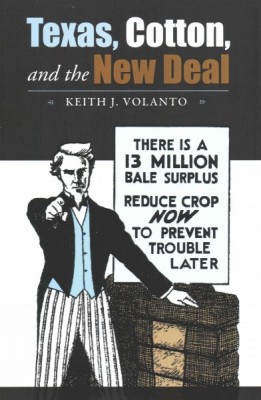| Texas, Cotton, and the New Deal: Volume 7 Contributor(s): Volanto, Keith J. (Author) |
|
 |
ISBN: 1603442995 ISBN-13: 9781603442992 Publisher: Texas A&M University Press OUR PRICE: $22.72 Product Type: Paperback - Other Formats Published: March 2015 |
| Additional Information |
| BISAC Categories: - History | United States - State & Local - Southwest (az, Nm, Ok, Tx) - Technology & Engineering | Agriculture - General - Business & Economics | Industries - General |
| Dewey: 338.173 |
| Series: Sam Rayburn Series on Rural Life, Sponsored by Texas A&m Uni |
| Physical Information: 0.6" H x 6.1" W x 9.1" (0.70 lbs) 216 pages |
| Descriptions, Reviews, Etc. |
| Publisher Description: Cotton supplied the Native Americans with clothing fibers before the Spanish ever entered Texas. It drew Southern settlers fleeing U.S. antislavery trends during the Mexican Republic in the 1820s. By the early 1930s, cotton was produced in 223 of the 254 counties in Texas and was a central element in the Texas economy. The Great Depression created a major disruption that threatened to destabilize the entire Lone Star State. In this book, Keith J. Volanto relates the story of the New Deal's efforts to aid Texas cotton farmers, specifically with the production-control policies introduced by the Agricultural Adjustment Administration (AAA). He explores the reasons the AAA cotton programs in Texas were instituted, the implementation problems the AAA encountered and how they were resolved, and the results of the programs. He draws conclusions concerning how well Texans benefited from the AAA cotton programs and about those who were actually harmed by them. In addition, he also examines the role of Texas politicians and bureaucrats in formulating the policies in Washington and the importance of Texas to New Deal cotton policy broadly. Volanto's study of the AAA cotton programs in Texas is a study not only of agriculture policy but also of the New Deal itself. The AAA provides an example of how the New Deal attempted to solve a natural problem in a largely experimental fashion. The experience of the AAA--the political, economic, and legal constraints it faced--provides new insight into the (Back Flap) nature of New Deal commodity programs. It also demonstrates how the New Deal's typical "broker state" priorities tended to address the concerns of organized groups, often to the detriment of unaffiliated individuals. From the initial farm subsidy programs and their impact on Texas during the 1930s to the AAA's cotton programs that were implemented at the state level, very little has previously been written on this important period in Texas' history. Texas, Cotton, and the New Deal fills this void. |